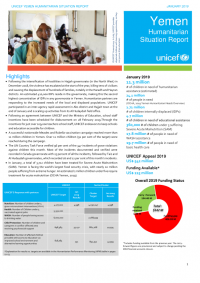UNICEF Yemen Humanitarian Situation Report (January 2019) [EN/AR]
Highlights
• Following the intensification of hostilities in Hajjah governorate (in the North West) in December 2018, the violence has escalated at the start of the year, killing tens of civilians and causing the displacement of hundreds of families, notably in the Haradh and Hayran districts. An estimated 420,000 IDPs reside in the governorate, making this the second highest concentration of IDPs in any governorate in Yemen. Humanitarian partners are responding to the increased needs of the local and displaced populations. UNICEF participated in an inter-agency rapid assessment in Abs district and Hajjah town at the end of January and is scaling up activities from its Al Hudaydah field office.
• Following an agreement between UNICEF and the Ministry of Education, school staff incentives have been scheduled for disbursement on 28 February 2019.Through the incentives for just over 109,000 teachers school staff, UNICEF endeavors to keep schools and education accessible for children.
• A successful nationwide Measles and Rubella vaccination campaign reached more than 11 million children in Yemen. Over 11 million children (91 per cent of the target) were reached during the campaign.
• The UN Country Task Force verified 96 per cent of the 347 incidents of grave violations against children this month. Most of the incidents documented and verified were recorded in Sa’ada governorate with 25 percent of all the incidents, followed by Taiz and Al Hudaydah governorates, which recorded 16 and 12 per cent of this month’s incidents.
• In January, a total of 3,712 children have been treated for Severe Acute Malnutrition (SAM). Yemen is facing the world’s largest food security crisis, with nearly 10 million people suffering from extreme hunger. An estimated 2 million children under five require treatment for acute malnutrition (OCHA Yemen, 2019).
Situation Overview & Humanitarian Needs
With no end in sight to the brutal conflict, the children and people of Yemen continue to suffer from the effects of the conflict, the economic crisis and the overall collapse in basic services. The Yemeni population is affected by the world’s largest food security crisis, with two-thirds of the population being food insecure. At present, Yemenis are more vulnerable and most food insecure than they have ever been since the escalation of the conflict in March 2015. An estimated 230 out of 333 districts in the country are at risk of famine. These districts are home to approximately 18.5 million people. The humanitarian response continues throughout the country, most notably in Al Hudaydah and Hajjah governorates following the escalation in violence over the last few months. UNICEF has been assisting the affected local and displaced population through the rapid response mechanism and water trucking.
The 2019 Humanitarian Needs Overview and the Humanitarian Response Plan are in the process of finalization and are scheduled for publication at the end of February. UNICEF will revise its 2019 Humanitarian Appeal for Children (HAC) accordingly.
https://reliefweb.int/report/yemen/unicef-yemen-humanitarian-situation-report-january-2019-enar


